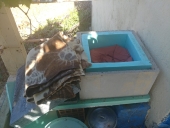
 10
10




www.thehappypermaculturalist.wordpress.com
 3
3




 10
10





www.thehappypermaculturalist.wordpress.com




www.thehappypermaculturalist.wordpress.com




www.thehappypermaculturalist.wordpress.com








www.thehappypermaculturalist.wordpress.com
 1
1








zone 8, 382.5 square meter garden 2 up 2 down 1920's ex-council house. heavy clay soil
 2
2




 8
8




The original link no longer works, but the book can still be obtained from the Internet Archive - athttps://archive.org/details/firelesscookbook00mitcrich
Here is a link that works now. Thank you, Joylynn! https://www.gutenberg.org/ebooks/60598

 3
3








 3
3




John Polk wrote:I spot read through "The Fireless Cookbook", (300+ pages) and found many good recipes.
Some were things that I would never eat myself, but many were things that were common 100 years ago, but seldom seen today. A treasure trove of homestead style rustic cooking.
A time I see where this technique would be a godsend is Harvest/Canning season.
When you have 100 pints of tomatoes that need to be processed and canned, these methods would save huge amounts of cooking fuels, as well as allowing you to go about your daily chores, without being shackled to the kitchen all day. Many crops are ready for harvest while it is still hot enough outside that you don't want the stove heating up the house all day.
Bushels of ripe fruits can easily be turned into 'ready to be canned' products with little time or intervention on your part.
Quarts of pie fillings, apple sauces, jams, etc could be 'cooking' while you are outside splitting fire wood (or butchering the hog). True permies style stacking of functions.
Besides saving a lot of cooking fuels, this method gives you back a lot of the time required for standard processing/cooking.




Living in Anjou , France,
For the many not for the few
http://www.permies.com/t/80/31583/projects/Permie-Pennies-France#330873
 1
1




Living in Anjou , France,
For the many not for the few
http://www.permies.com/t/80/31583/projects/Permie-Pennies-France#330873
 1
1




 3
3




David Livingston wrote:Well I have nearly finished making my Wonderbox
Cost so far my time plus a couple of yards of Cotton . The material came from some two pairs of trousers ( patched) a pair of bermudas And an old tea towel. Now I need to stuff it. I' m not keen on Polystyrène . Anyone any other suggestions preferably stuff I can er find or make:-) that Will cope with the Heat.
I am keeping the spare material to make a proddy mat
but thats a story for another thread.
David
"You must be the change you want to see in the world." "First they ignore you, then they laugh at you, then they fight you, then you win." --Mahatma Gandhi
"Preach the Gospel always, and if necessary, use words." --Francis of Assisi.
"Family farms work when the whole family works the farm." -- Adam Klaus




The highest function of ecology is the understanding of consequences.
 6
6




 1
1




 1
1




paul wheaton wrote:I would very much like to see this thread get fleshed out a lot more. More pictures, more links to blogs, more embeded videos, more, more, more .... So, in that spirit, I will pony up a permies.com care pacakge of two mugs, two tshirts and two decks of cards (see http://homesteadgear.com/ for details on these items) to the best post in this thread over the next few days.
(this post will self destruct in four days)
"It is no measure of health to be well adjusted to a profoundly sick society." - J. Krishnamurti
 4
4




 6
6




Visit Redhawk's soil series: https://permies.com/wiki/redhawk-soil
How permies.com works: https://permies.com/wiki/34193/permies-works-links-threads
 1
1




 4
4




Livin' on a thread.
 5
5




Living in Anjou , France,
For the many not for the few
http://www.permies.com/t/80/31583/projects/Permie-Pennies-France#330873




 5
5




Jay Angler wrote:
2. From "Product Safety Australia" - "Materials such as cotton, cotton/polyester blends, rayon and acrylic are generally more combustible than 100 per cent polyester, nylon, wool and silk. The weave is also a factor in determining flammability. Fine threads with open weaves are more combustible than heavy, closed weaves of the same material." ....so if you want to be safe, the inner lining should be a tightly woven wool rather than cotton. This site, http://www.vintagevisage.net/Burn_Chart.html , gives a chart to help you confirm what a material is if you are re-purposing fabric. I used a wool shirt from a Thrift shop to re-cover some oven mitts, and it has been very successful. The original covers were cotton and they didn't stand up all that well.




Livin' on a thread.
 2
2




Living in Anjou , France,
For the many not for the few
http://www.permies.com/t/80/31583/projects/Permie-Pennies-France#330873
 1
1





Living in Anjou , France,
For the many not for the few
http://www.permies.com/t/80/31583/projects/Permie-Pennies-France#330873




Living in Anjou , France,
For the many not for the few
http://www.permies.com/t/80/31583/projects/Permie-Pennies-France#330873
 1
1




 2
2








K Nelfson wrote:
Cooking fuel is minimal. At least, compared to running a freezer. And running a freezer is minimal compared to heating/cooling your house.
Here's a link to some research I did on the topic. I figured that canning would be more efficient over the long term but that a freezer would take less energy if the food was stored for, say, a few months. Turns out that it's not so.
https://docs.google.com/document/d/1WeOt4vE_dQKWg1Gz8kDCWiFNpgkR6WPeFtOo_dEvLKk/edit?usp=sharing
 8
8





Windward Sustainability Education and Research Center
Permaculture Apprenticeships at Windward
America's First Permaculture Cemetery? Herland Forest Natural Burial Cemetery

|
this llama doesn't want your drama, he just wants this tiny ad for his mama
Freaky Cheap Heat - 2 hour movie - HD streaming
https://permies.com/wiki/238453/Freaky-Cheap-Heat-hour-movie
|





